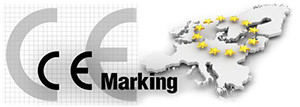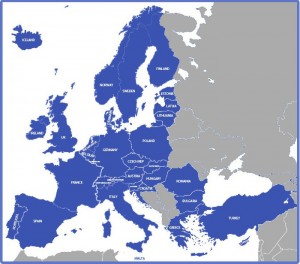
About CE Marking
So, you know you need CE Marking to put your machines or products into Europe, but you’re not sure where to start.
 We understand. We know it can look a confusing process at first, with so many European Directives, Standards, and other regulations to obey.
We understand. We know it can look a confusing process at first, with so many European Directives, Standards, and other regulations to obey.
That’s precisely why ARC Management Systems is such a help to firms like yours. We guide you through every step of the CE way, compiling all the technical reports and other documentation as we go, and finally giving you the go-ahead to use the CE Mark.
We’re also here to answer all your questions about CE Marking.
What is CE Marking?
CE Marking is a recognized sign that a machine or product complies with European health, safety, and environmental protection Directives and Standards.
It does not indicate that the machine or product was produced in Europe. An item bearing the CE mark could have been manufactured anywhere in the world – but the CE mark is necessary to allow it use or sale in Europe. The CE Mark is not a quality mark either – it simply represents that minimum requirements are being met.
Why do I need CE Marking?
Because it’s the law. All machines and products governed by the various European Directives must have the CE Mark attached in order to be placed into Europe for use and/or sale. Failure to do so can lead to sanctions.
Having the CE Mark also allows for easier shipping of machines and/or products throughout Europe. European Union law says that so long as a machine or product is CE compliant, it can move freely from one member state to any other. Countries can only restrict movement by showing that the item doesn’t actually comply after all.
How do I get CE Marking?
Getting CE Marking can be a straightforward process but it’s one that can turn very complicated very quickly without specialist expert help. First, you must identify the appropriate Directives and Standards for your machine or product. Then, you ensure that you comply with them, either using your existing processes or by changing these as necessary. After that, you need to produce a series of technical and user documents, according to very strict criteria.
You could do it yourself – just as you could service your automobile engine too. But most of us prefer to leave that job to the experts. And CE Marking is a job that experts like us can help you with too.
What is the difference between European Directives and Standards?
They’re all rules, right? So why not just call them all the same thing? Why do we need both?
This is just one of the areas where you can go wrong if you try for CE Marking yourself. But we’re here to take you through it. Basically, a Directive is the general guideline for what a machine or product must comply with in order to qualify for CE Marking. There are 26 of these, and they are relatively straightforward.
A Standard holds the specifics of how exactly to comply with all those conditions. They are much bigger, and more complicated, and there are hundreds of them.
Think of it like a football match. A Directive would say you’ve got four downs to make ten yards, and you’ll get six points if you score a touchdown. The Standards will set out all the finer details of the game – formation at line of scrimmage, tackling allowed and interference not allowed, timekeeping, and so on. Imagine trying to explain all that to a European who’d never seen football before. In the same way, we will guide you through all the Standards you probably haven’t dealt with before either.
What countries do I need CE Marking for?
CE Marking is needed for all countries who are members of the European Union (EU) and/or the European Economic Area. These are (in alphabetical order):
Austria, Belgium, Bulgaria, Croatia, Czech Republic, Cyprus, Denmark, Estonia, Finland, France, Germany, Greece, Hungary, Iceland, Ireland, Italy, Latvia, Lithuania, Liechtenstein, Luxembourg, Malta, Norway, The Netherlands, Poland, Portugal, Romania, Slovakia, Slovenia, Spain, Sweden, United Kingdom (Great Britain)
- Note that Switzerland is not a member of either the EU or the EEA, but for some products it accepts the CE marking as a presumption of conformity with Swiss national technical regulations.
- Similarly, Turkey is not part of the EU or EEA, but it has fully implemented many of the European CE Marking directives. This means that for many products, they also require CE marking.
Is CE Marking the same as UL or CSA Marking at home?
In a word – no. Firms with UL Marking in the USA or CSA Marking in Canada should see CE Marking for Europe as a completely separate consideration. Never assume that just because a machine or product is UL or CSA Marked that it will automatically or easily qualify for CE Marking too.
Sometimes it will, but sometimes there can be huge differences in the requirements too, and several modifications may be necessary. Experts from ARC Management Services will guide you along the way.
How long does it take to get CE Marking?
We’re afraid there’s no easy answer to that one. It all depends on the machine or product. For some – maybe a matter of days. For others, requiring several site visits and modifications, it could take months. But what we can tell you for sure is that our dedicated staff will work with you for as long as it takes, to make sure you have absolutely everything you need for CE Marking.
How much does CE Marking cost?
That’s another ‘how long is a piece of string?’ question, and it’s impossible to answer as it will vary wildly depending on the scope and complexity of every single project. What we can tell you for sure though is that once we have all the necessary details of the product or machine you want CE Marking for, we will give you a cost estimate that won’t be beaten for the level of service and expertise we’ll provide.

